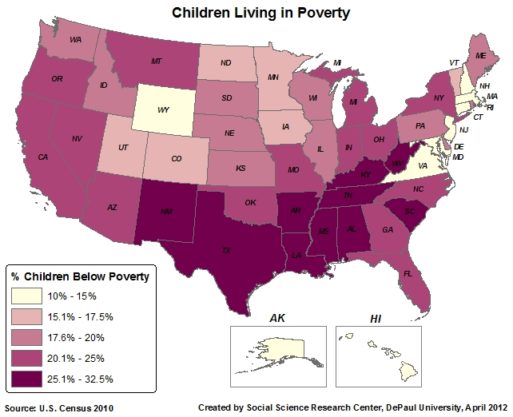A study published in the journal Health Affairs in January shows that children in the United States are 70 percent more likely to die before reaching adulthood than those in 19 other developed nations. Researchers estimate that, between 1960 and 2010, this translates to about 600,000 deaths that would not have happened if these American children had lived in other wealthy parts of the world.

The U.S. ranks a dismal 26th in the world in infant mortality rates
The study compared childhood mortality rates in 20 wealthy countries, including Canada, the United Kingdom, Sweden, Australia, France and the United States. All of the countries in the study have seen a decrease in the number of childhood deaths since 1960. But since the 1990s, the United States has consistently topped the list.
Infants and Teens Most Affected
Infant mortality in the United States has historically been higher than in many developed nations. In 2010, the rate of death for U.S. infants was 6.1 per 1,000 live births — more than double that of Finland, Sweden, Portugal and Japan. U.S. infant mortality at that time was also higher than in 25 other countries, including Denmark, Korea, Hungary, Poland and Greece. According to this latest study, the risk of death for American infants was 76 percent higher than in 19 other developed nations, and the mortality rate for extremely premature infants was three times as high.
Teenagers, too, are at a much higher risk of death here in the United States. Not surprisingly, gun violence accounts for many of these fatalities. Teenagers between 15 and 19 are 82 times more likely to die from gun violence here than in the other countries in the study, in large part because residents of the U.S. own about half of the total civilian-owned firearms in the world. American teens are also twice as likely to die in a car wreck as teens in other developed countries, the study found.
Poverty and Fragmented Healthcare to Blame
Our fragmented healthcare system is almost certainly part of the reason for the disparity in health outcomes between children in other developed countries and the United States, according to the lead author of the study, Ashish Thakrar. Even though economically disadvantaged women automatically qualify for Medicaid when they are pregnant, they may not have received routine healthcare for many years, Thakrar explains. “Mothers who are qualifying for Medicaid for the first time because they’re mothers might be seeing doctors for the first time. They might not have a family physician, or a clear support system,” he said. Thus, their children are more likely to be born prematurely or with congenital abnormalities — two of the three leading causes of infant deaths in the U.S. (Sudden infant death syndrome is the third.)

Credit: Social Science Research Center at DePaul University
American children are also more likely to live in poverty than those in other developed nations, research shows. According to a report from the United Nations Children’s Fund, the United States ranked 34th of 35 wealthy nations in rates of childhood poverty in 2012. A similar report from the Organization for Economic Cooperation and Development in 2014 ranked the United States 35th of 40 member nations, above only Chile, Mexico, Romania, Turkey and Israel.
Given that poverty is clearly a contributor to negative health outcomes both in childhood and later in life, it’s not surprising that America’s childhood death rate is high as well.
Americans Are Dying Sooner Overall
This disturbing trend in childhood death rates is part of an overall decrease in life expectancy in the United States. Since 2015, the life expectancy of the average American adult dropped two years in a row, from 78.9 to 78.6 years. Not a huge change, certainly. And according to Bob Anderson of the U.S. Centers for Disease Control and Prevention’s National Center for Health Statistics, not enough of a change to be labeled a “trend.” Yet, with opiate deaths and suicides still on the rise, life expectancy may well dip again for 2017. And without a meaningful commitment from policymakers to address the underlying social and economic factors that are weighing on the nation’s health, it’s unlikely that the life span of American children or adults will improve any time soon.

 American Children Die More Often than Kids in Other Developed Nations
American Children Die More Often than Kids in Other Developed Nations


 Our Monthly Tip: Make an “In Case of Death” File to Ease Loved One’s Grief
Our Monthly Tip: Make an “In Case of Death” File to Ease Loved One’s Grief
















